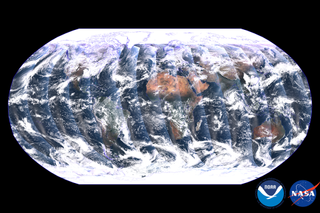Earth looks stunning in this 1st full view from the NOAA-21 satellite (photos)

What can you spot in this latest global picture of Earth? There are crisp turquoise seas around Cuba, an agricultural fire in Northern India and, of course, the rest of our planet as seen in the first full view from NOAA's latest Earth-observing satellite NOAA-21.
The Earth images that make up this mosaic, and a few closeups, were taken on Dec. 5 and Dec. 6 by an instrument called the Visible Infrared Imaging Radiometer Suite (VIIRS) aboard the satellite, which launched on Nov. 10 from the Vandenberg Space Force Base on Nov. 10. (The spacecraft was previously known as JPSS-2.) VIIRS collects images in both the visible and infrared light spectra, allowing scientists to see details of Earth's surface.
Related: Powerful new Earth-satellite to study weather's 'butterfly effect'


VIIRS provides vital information to scientists about Earth's oceans, atmosphere and land. It can detect differences in the ocean's color, telling scientists where phytoplankton are, or whether dangerous algal blooms have formed along human-settled coasts. The instrument's atmospheric data can help scientists forecast and monitor storm movement.
NOAA-21 is the second operational satellite in a series called the Joint Polar Satellite System, which provides global, pole-to-pole images. The last JPSS satellite, now known as NOAA-20, launched in November 2017. Before that, the NOAA-NASA Suomi National Polar-Orbiting Partnership (Suomi-NPP), which provided a blueprint for the JPSS, launched in 2011.
The satellites orbit pole-to-pole, observing the entirety of Earth's surface twice per day. It cruises 512 miles (824 kilometers) above Earth at 17,000 mph (27,360 kph) and crosses the equator 14 times per day. And they all carry a VIIRS instrument.
The third JPSS satellite is slated to launch in 2027, and the fourth doesn't yet have a launch date.
Get the Space.com Newsletter
Breaking space news, the latest updates on rocket launches, skywatching events and more!
Follow us on Twitter @Spacedotcom and on Facebook.
Join our Space Forums to keep talking space on the latest missions, night sky and more! And if you have a news tip, correction or comment, let us know at: community@space.com.

JoAnna Wendel is a freelance science writer living in Portland, Oregon. She mainly covers Earth and planetary science but also loves the ocean, invertebrates, lichen and moss. JoAnna's work has appeared in Eos, Smithsonian Magazine, Knowable Magazine, Popular Science and more. JoAnna is also a science cartoonist and has published comics with Gizmodo, NASA, Science News for Students and more. She graduated from the University of Oregon with a degree in general sciences because she couldn't decide on her favorite area of science. In her spare time, JoAnna likes to hike, read, paint, do crossword puzzles and hang out with her cat, Pancake.
-
CountChocula NOAA? As in, the American organization?Reply
🤔
Possibly a silly question, but why isn't that country in the center of the pic? Residents can barely see their own country!
:tearsofjoy:
"Excellent work team! But next time, could we get a shot where the nation is completely unseen?"